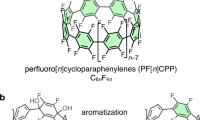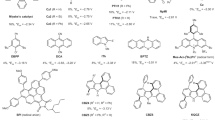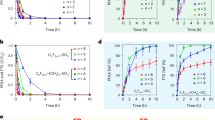Abstract
A molecular mechanics force field method (MMFF94) systematic rotor conformational search was conducted on the well known environmental contaminant n-perfluorooctanoic acid (n-PFOA). The MMFF94 conformational search yielded 2915 separate low- through high-energy conformers of n-PFOA. Ranking of these structures gave the 94 lowest MMFF94 energy conformations that were subjected to subsequent density functional theory (DFT) computational investigations at the B3LYP/6-311++G(d,p) level of theory. Application of a thermodynamic cycle approach, coupled with aqueous and gas phase DFT calculations on the molecular and anionic forms for each of the 94 lowest energy n-PFOA conformers, gave estimated acidity constants (pK~a~ values) for a final converged set of twelve n-PFOA conformers, including the global minimum helical perfluoroalkyl chain geometry and eleven non-helical higher energy conformations. Collectively, the twelve lowest energy conformers appear to completely encompass the global conformational space for n-PFOA, indicating no higher energy conformations likely remain that could appreciably influence the observed composite aqueous pK~a~ of this compound. The estimated pK~a~ values of all eleven non-helical n-PFOA conformers were within 0.1 pK~a~ units of the helical conformer pK~a~. The findings support previous predictions and recent experimental evidence for an aqueous phase n-PFOA monomeric pK~a~ of about zero.
Similar content being viewed by others
Article PDF
Author information
Authors and Affiliations
Rights and permissions
About this article
Cite this article
Rayne, S., Forest, K. Theoretical studies on the pK~a~ values of perfluoroalkyl carboxylic acids: Non-helical conformation acidity constants for n-perfluorooctanoic acid (n-PFOA). Nat Prec (2009). https://doi.org/10.1038/npre.2009.3837.2
Received:
Accepted:
Published:
DOI: https://doi.org/10.1038/npre.2009.3837.2



